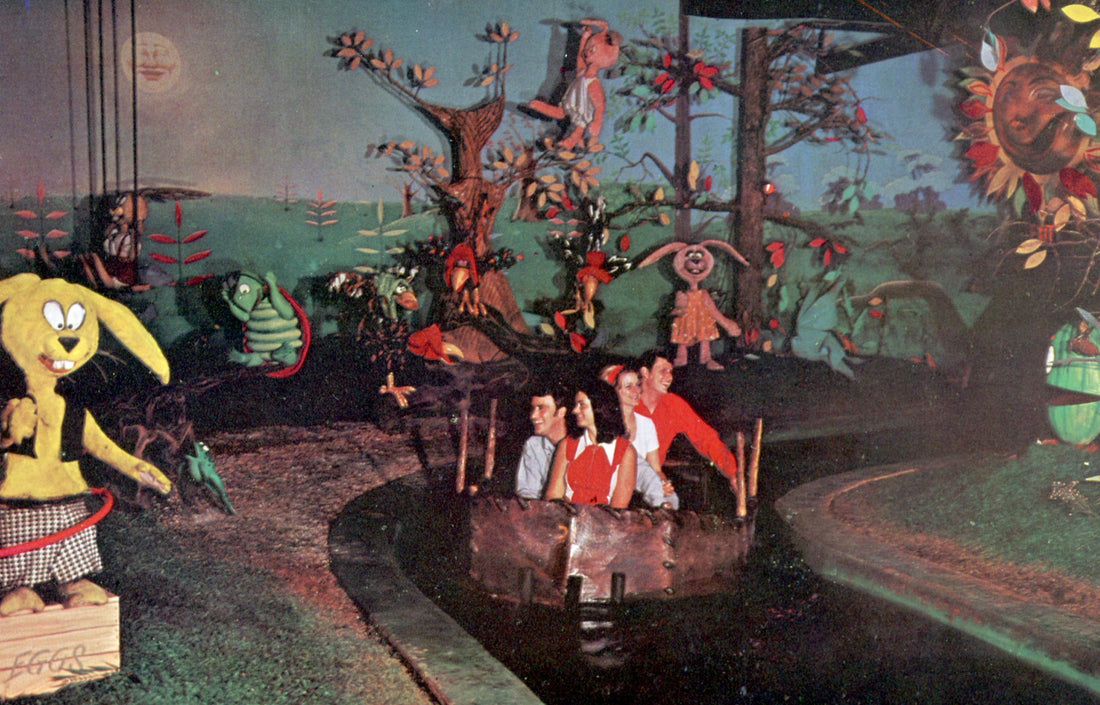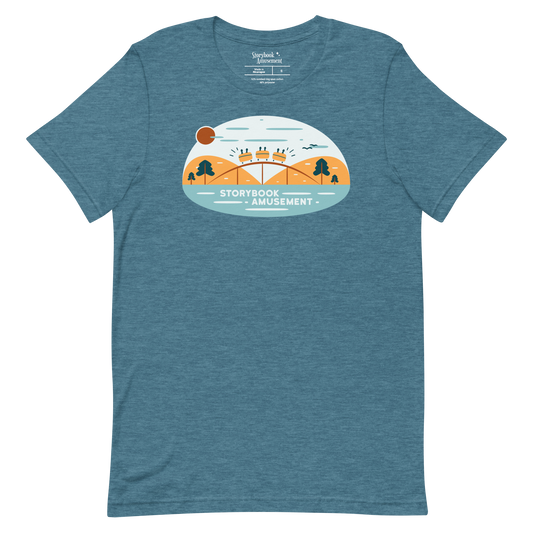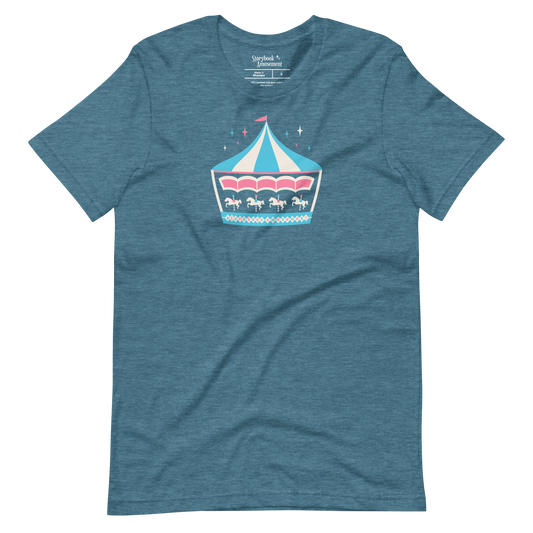Six Flags Gets Its First Dark Ride
The founder of Six Flags, Angus G. Wynne, was inspired to build a theme park of his own after a visit to the recently opened Disneyland. Shortly after in 1961, Wynne debuted his brand-new park, Six Flags Over Texas, impressing local guests with nice theming and a family-friendly atmosphere.
The flagship Six Flags park took a magical turn in 1964 with the addition of its latest attraction, Speelunker’s Cave. Guests immediately fell in love with the cute yet creepy boat ride that ventured through the underground caves of a big-eyed alien society.
Watch on YouTube
This article is available in video form with added visuals. Click HERE to watch it.
Six Flags Goes East
Six Flags Over Texas, though still a young theme park, had been successful enough that Wynne settled on building a second Six Flags park—this time, on the East Coast. In 1965, Wynne purchased 3,000 acres of land on the outskirts of Atlanta for $5 million, dedicating nearly a tenth of the property for his next attraction. In a few years, the site in Austell, Georgia, would be the location of the Southeast’s newest theme park.
Wynne had many plans for what would become Six Flags Over Georgia. The park’s identity would be very similar to that of Six Flags Over Texas, featuring comparable attractions such as a mine train coaster, a riverboat ride, a train ride, a log flume, and many other classic offerings.
A Creative Ride to Keep the New Park Afloat
Following the positive reception of Speelunker’s Cave at Six Flags Over Texas, Wynne wanted to bring a similar kid-friendly boat ride to his upcoming theme park, Six Flags Over Georgia.
The beloved Speelunker’s Cave set the framework for what was to come at the Georgia-based theme park. Speelunker’s Cave had a relatively local theme—considering that caves were being discovered around Texas at the time. The imminent boat ride at Six Flags Over Georgia too would have a somewhat locally inspired story to fit within the concept of Six Flags.
Just like the initial Texas park, Six Flags Over Georgia had six themed lands based on the six different flags that at some point in history have had control within the state. One of the themed lands, disappointingly set to the Confederate States of America, was the future site of Six Flags’ next legendary indoor boat ride, with a price tag of $360,000.
The concept of the upcoming ride was centered around the Br’er Rabbit stories as published by Georgia-based author Joel Chandler Harris. Those connections plus its ties to Georgia’s Okefenokee Swamp gave the ride its local-leaning focus that fit within the concept of Six Flags.
Six Flags once again partnered with the established Arrow Development to manufacture an indoor boat ride system. The creatives at Six Flags worked on the ride’s story and various scenes that brought the folklore to life.
Within two short years, Six Flags Over Georgia was developed, constructed, and ready for the public by the summer of 1967. Waiting in the middle of the hilly and tree-covered destination was the park’s only dark ride, and certainly its most distinctive: Tales of the Okefenokee.
The Original Tales of the Okefenokee
Tales of the Okefenokee has gained infamy among fans, but the earliest version of the ride has faltered into obscurity. The ride as it was in the park’s opening year has gone mostly undocumented. Not much is known about it aside from brief footage, rare promotional materials, and sparse descriptions.
The attraction started with guests lining up in the lattice-covered queue with decorations of the ride’s characters on the outside facing the pathway. An upbeat song played on a loop overhead, sharing the storyline of the adventures that awaited inside.
The Disney-quality musical number was glorious, but its grandiose melody outclassed what guests could expect on the ride.
The Ride Experience in 1967
Tales of the Okefenokee, in a similar style to Speelunker’s Cave in Texas, followed a 700-foot trough. Riders boarded Native-American-style boats that floated through various scenes with animated characters—this time, following the stories of Br’er Rabbit, known as “Mr. Rabbit” in the ride.
Once boarded, guests went on a journey through colorful backcountry sets past the ruins of an old plantation and musical woodland scenes. Endearing creatures—such as rabbits, frogs, and woodpeckers—were seen around the banks of the river as Mr. Fox and Mr. Bear chased Mr. Rabbit.
Their escapades lead the boats into a dark frightening storm, passing through the underground burrows of the rabbits, and ending in a bubbly finale of celebration.
Reception of the Original Version
Tales of the Okefenokee was designed and built with modesty, but its colorful and melodic environment made it a memorable attraction with an artistically outdoorsy style that blended into the wooded Six Flags park.
Unfortunately, Tales of the Okefenokee didn’t get the same praise Speelunker’s Cave out in Texas got, even though it was produced in-house by some of the same creatives who made The Cave. The low-budget Tales of the Okefenokee came across as more shabby than sensational.
The small, gregarious characters were lovable in Speelunker’s Cave with the miniature alien species running around the underground caves. However, in Tales of the Okefenokee, the same small type of animatronics—the largest of which were a mere 5 feet tall—were disenchanting in their vibrant surroundings.
The ride had satisfying scenic design, but those expansive sets made the animated characters unimpressive by comparison. Despite being a ride unlike any other in the park, the simple yet somewhat outlandish boat ride was not up to the standards Six Flags founder Angus G. Wynne had set for the park.
Overall, he was not satisfied with how the ride turned out. Tales of the Okefenokee was one of several attractions Wynne planned to modify before the park’s second season.
Supposedly, as soon as Six Flags Over Georgia welcomed its first guests, park leadership already started planning a major upgrade for Tales of the Okefenokee. The ride in its original form lasted only through the inaugural 1967 season—having operated for less than a year—before undergoing significant updates.
A Complete Overhaul
Six Flags in its early days partnered with rising puppeteers Sid and Marty Krofft. The visionary duo, in addition to their popular work on TV, already had puppet theaters in both the Texas and Georgia Six Flags parks.
The two knew how to connect with kids, and Six Flags needed their help once again. The park reached out the Kroffts asking for their help with revamping the unsuccessful Tales of the Okefenokee ride. Sid and Marty Krofft put their whimsy to work and began to transform Six Flags Over Georgia’s lone dark ride into the version that would soon be remembered fondly by many parkgoers.
The Kroffs overhauled the ride by designing larger characters with friendly, exaggerated facial features that almost seemed like costumed characters. Their cartoony and adoring style took the place of the ride’s original slender and simple animatronics. The old characters were replaced with towering, smiling animals that made the entire ride larger than life.
As for the sound design, the Kroffts recorded new voiceover, sound effects, and musical numbers to give the ride a new heartbeat.
Bringing the Swamp to Life
Art Lozzi, who worked as a background artist on Hanna-Barbera productions, helped realize the redesign with illustrations of characters and scenes for the ride.
Though the presentation of Tales of the Okefenokee was being rebuilt, the attraction’s show building, ride system, and track were left untouched. Much of the existing sets remained as new air-powered animatronics were installed. Even though some of the attraction’s features carried over to the new version, the large-scale changes noticeably elevated the overall experience.
This version of the ride has been documented in greater detail than the original thanks to the enthusiastic preservation efforts of pop culture historian Tim Hollis in addition to the media collections of a few others.
The Ride Experience Starting in 1968
The refurbished Tales of the Okefenokee reopened at the start of Six Flags Over Georgia’s second season in 1968.
The exterior of the ride remained mostly the same with new flat characters now in the landscaping just outside the ride. Guests waited in the same lattice-covered queue that played the same sensational song that was heard in the same area from the original version of the ride.
The tune’s lyrics were unchanged and still told the story of the original version of the ride, even though the narrative of the attraction itself had been modified. Regardless, the ride at its core had the same main characters and carried through a very similar cadence with Mr. Fox and Mr. Bear chasing after Mr. Rabbit. That said, the song was close enough narratively; more importantly, since Tales of the Okefenokee received major improvements, the ride now matched the quality of the existing bright and extravagant song.
After queuing, guests stepped onto a dual-sided load and unload platform as they boarded the old six-passenger Native American style boats and floated toward the show building. To kick off the ride, two flat rabbits around the entrance held up signs—one reading, “Please keep hands inside the boat,” and the other jestingly stating, “Do not feed the bunnies.”
The experience officially began inside, introducing riders to the hand-crafted countryside wilderness. A choir of crows on the left welcomed riders with a chorus:
“Welcome, neighbor, welcome
To the Okefenokee
Welcome, neighbor, welcome
You surely made our day...
Let’s get on our way”
Spanish moss hung from above as owls hooted at riders passing by. Around the bend, the boat approached an old plantation reclaimed by nature; creatures relaxing on the side had lines cast into the fishing hole. This peaceful scene was the first time riders met Mr. Rabbit as well as Mr. Fox and Mr. Bear. Everyone was getting along while a raccoon enjoyed a picnic basket, a lazy turtle unashamedly snored, and other critters enjoyed the restful moment.
The river made a turn, passed through a dark cave, and was met with calamity on the other side. A band of creatures stood in a line on the banks, playing makeshift instruments like washboards and jugs. One bunny found themselves in a jam and managed to use a toilet plunger as a trumpet.
The sounds of this backyard band were quickly drowned out by the frantic harmonies of a carrot choir. While wearing expressive makeup, the carrots and their simple mouth moments sang:
“Save the rabbit
Save the rabbit
Whatever you do
Or else he’s gonna end up
In a kettle of stew”
All the characters on the ride up until this point were all smiling and getting along, but the forewarning from the carrots soon became clear.
Up ahead was the ride’s first conflict: The giggling, guileful Mr. Fox and Mr. Bear were kidnapping Mr. Rabbit, stuffing him into a sack. In the background amid commotion, a chicken cried and clucked from the window.
The devious duo would meet their comeuppance in the next scene as owls clinging to a bed sheet swirled over Mr. Fox and Mr. Bear like a ghost. After being courageous moments earlier, the two cowered in fear from the ghostly prank.
They were teased even more in the following scene as two nearby rabbits played with unflattering marionette puppets, making a mockery of Mr. Fox and Mr. Bear. Across the river, a family of carefree rabbits enjoyed themselves by casually lounging outside, as one of them milked a cow. They were acting as colorful and laid back as the ride had been up to this point, but that wouldn’t last.
Tales of the Okefenokee featured one of the grimmest mood shifts in any dark ride. The singing crows reappeared—this time, perched on a log—to warn riders of the dangers and mysteries up ahead.
“Before you go further
We just thought we’d warn ya
There’s a creatures up ahead now
Are liable to scorn ya...
Go back! Go back!
Turn around! Go back!”
From here, the river led into a dark cave that curved to the left. At the turn, Mr. Fox and Mr. Bear waited along the banks with an arsenal of explosives. It was open fire; sounds of blasts filled the cave while the creatures pointed their weapons directly at the boat.
Riders, for the first time in the attraction, were in immediate danger. Gone were the happy-go-lucky scenes and antics—the ride’s tone took a complete one-eighty as children aboard the boats covered their eyes.
The flowing water led to a small lift hill with Mr. Fox and Mr. Bear dangling from a fallen tree above the ride path. They swung their orange-glowing lanterns, cautioning riders of the most terrifying scenes ahead.
“Beware, beware
Go back, go back”
The boats plunged into the darkest corner of the swamp, bobbing against the wave of a splash as a violent storm took over. Fans blew gusts of wind while creaking trees lunged forward, bats scurried above, alligators snapped their jaws, rattlesnakes intimidatingly shook their tails, owls hauntingly hooed, and lightning crashed to pierce the darkness.
The nightmarish scene ended by passing through a briar patch, which was believed to have actual briars.
The river led to the safety of the rabbit family’s underground burrow with roots bursting through the dirt ceiling. It was a holiday celebration as rabbits gathered around the table, peacefully enjoying each other’s company in harmony. With the sound of sleigh bells, the kids sang a festive Okefenokee carol while feasting.
Just outside the underground cave, Mr. Fox and Mr. Bear weren’t as jolly as the rabbits. They were plopped in a frog pond and drenched in defeat while croaking amphibians hopped on the sulking scoundrels.
They were quickly disturbed in the next scene as Mr. Rabbit teased a beehive with a long stick, keeping a safe distance. Buzzing bees strung across the scene swarmed Mr. Fox and Mr. Bear as they comically scurried their feet in complete panic. This was the last riders would see of the foiled Mr. Fox and Mr. Bear—their faces animated in distress.
With Mr. Fox and Mr. Bear scared off, the smiling rabbits and creatures reunited for one final hurrah in a chaotic yet celebratory fashion. In jubilee, the lush woods nearly transformed into a carnival as a rabbit juggled, a raccoon swayed with bunnies on their shoulders, a rabbit and a turtle bounced on a seesaw, a bunny swung from a playground without worry, a rabbit hula-hooped, a cottontail performed magic tricks, and another floated off with their hand full of balloons.
In the same way the ride started, the anthemic crows sang goodbye to the riders. Across the way, four singing watermelons joined in on the bright celebration. Finally, a raging sun above belted out jovial laughs, and Ms. Rabbit sent riders off with a warm invite:
“Bye now. Y’all hurry back, ya hear?”
The boats entered a cave lined with a kaleidoscope of multi-colored diamonds before being blasted with sunlight and returning to the real world.
Reception of the 1968 Version
The new version of the ride was overly detailed and extravagant, like entering the pages of a storybook. The words of Ms. Rabbit to “hurry back” were exactly what guests did for years and years to come.
Tales of the Okefenokee was appreciated for more than its peaceful air conditioning and being a dim, secluded place for young couples to get some privacy—it was a nice diversion in the park that children and families fell in love with.
What made it so special was that it was a ride unlike any other in the park and was essentially unmatched in its time. Disneyland was thousands of miles away, and Walt Disney World was years away from opening. Yet, Tales of the Okefenokee managed to leave an impact on many guests of all ages.
Still, Tales of the Okefenokee was somewhat of a hidden gem lost in the thick of The South. It wasn’t necessarily Six Flags’ headlining attraction—it was almost downplayed among the park’s lineup. However, its overemphasized style and whimsy made it a beloved ride within the park.
It was a part of Six Flags Over Georgia’s personality as the ride also had walkaround characters. The ride was even popular enough to have its fair share of sponsorships too.
Beyond being a one-of-a-kind attraction, Tales of the Okefenokee stood out because of its presentation. It was created by a group of puppeteers who knew how to visually tell a story and how to make a positive impression on kids. The colorful sets made a splash, the specially written music was nearly movie quality, and the characters brought a smile to kids’ faces.
The employees who worked at this attraction loved doing so. It was among the more fun venues in the park to work at, and they may have been known for taking a dip in the water after hours to make the most of their time there.
Tales of the Okefenokee was imaginative, creative, and almost unexpected to an extent in a beautifully done way—but that’s not to say the ride was perfect.
Swampy Imperfections
Though it was rich with details to appreciate, it was a pretty simple ride. The animatronics had very basic movements if any at all. But, they were nice animatronics for the time, especially in a regional park. While yes, the ride had an unreal dreaminess to it, it was calamitous in a way that made it feel somewhat homemade.
Tales of the Okefenokee, to its credit, had several elaborate scenes. The ride may seem vast when hearing about all the details nowadays, but the reality was that the scenes were crammed into a relatively small space. With very few barriers between the numerous sets, the whole ride more or less blended together in a confusing way. This caused the sound effects and music to overlap through multiple scenes, causing a dissonant effect and a generally messy mix of noises.
And on top of that, the sound design was inconsistent. Allegedly, the underground rabbit scene on occasion didn’t have any music because the back-of-house employees would shut it off since it could be heard through the walls. They didn’t want to hear sleigh bells throughout their shift, but it took away from the experience for guests.
But most disappointingly, the ride did not hold up well with each passing season. For example, the damp building was not kind to the fur on the animatronics.
To the park’s credit, this was eventually addressed as the animated characters were given new fur and outfits in the mid-‘70s to keep the ride fresh. Be that as it may, their design choices were questionable as the characters then had brightly colored fur and out-of-place costumes. The new look changed the feel of the overall experience, making it a bit tackier than when it first opened.
Tales of the Okefenokee operated for several years with this erratic style. For many riders, this is the condition they saw the ride in—not the wistful look of yesteryear. This may lead some to believe the ride was in complete disrepair toward the end of its lifespan. While the late Tales of the Okefenokee may have been shabby, especially compared to its early years, it was still a popular attraction that was decently maintained.
Actually, the foreman on duty was tasked with riding the attraction once per hour to ensure all the elements were in good working condition. Another employee was stationed near the lift to monitor how well the ride was running at any given time. All this is to say, the ride was being looked after.
Disappointingly, Tales of the Okefenokee was subject to some vandalism. This was a result of the boats not having a restrictive restraint system, so riders could easily hop out of their seats and walk on the sets, even stealing props in some cases. The trough was allegedly widened in some areas to minimize this issue. Employees also were usually quick to notice any wanders and dealt with them before anything happened in most cases. Still, the ride was wearing down to some capacity as the scenes themselves never received any major refurbishments.
Firery Malfunctions
The mechanics of the animatronics were not in the best condition later on, especially as the ‘80s approached. The attraction has even been called a “nightmare” by maintenance crews as the antiquated animatronics started wearing out. As an example, the singing carrots were breaking down one by one. Once a carrot was out of service, it was removed and replaced with shrubbery. This was happening so often that the choir quickly became quite sparse. There also may have been instances of animatronics emitting exhaust, to an extent.
Over time, as more and more details started waning, Tales of the Okefenokee wasn’t being held to a high standard anymore. It wasn’t practical for the park to fix every little issue the ride had; those issues were increasing in number each season. Tales of the Okefenokee was on borrowed time.
By 1980, over a decade after the ride opened, one of the singing carrots badly malfunctioned and caused a fire. Six Flags addressed the affected areas by removing some theming and updating a backdrop—most notably, they removed the singing carrots entirely. The singing watermelons from the end of the ride were relocated to the carrots’ spot at the beginning. The watermelons looked out of place, but that was more or less the condition the entire ride was in at the time. Six Flags made due.
The status of the ride in these later years was a culmination of many issues adding up.
Six Flags Made Improvements
Six Flags Over Georgia, now more than a decade into operation, had made major additions around the park. As the company’s executive vice president, Errol McKoy, put it, “We have to keep changing the face of this park every single year. Six Flags Over Georgia will never be finished.”
Six Flags had to stay to that promise if they wanted to keep up with the competition. In 1971, Walt Disney World opened in Orlando, Florida—only a day’s drive away from most of the Southeast. Before then, the only way to experience a Disney park was to visit Anaheim, California, which was more than 2,000 miles away from Atlanta. The next best thing local to the South was Six Flags. That was no longer the case. The new Disney resort was attracting tourists from the Southeast region, so Six Flags had added pressure to provide new offerings.
In the coming decade, Six Flags Over Georgia added new thrills that blended with the values of family entertainment the park was founded on. Major additions through the 1970s included the world’s tallest coaster at the time as well as a $2.5-million steel coaster that was touted as the first triple-looping coaster—although that record was a stretch.
With new thrilling coasters and expansions, the park had evolved beyond its opening-day form. “We’re going to be doing things differently in the ‘80s,” said Spurgeon Richardson, the park’s general manager at the time.
Leading into the 1980s, Six Flags opened a new expansion land called Jolly Roger’s Island. The 3-acre area cost the park $2.2 million and set the stage for the ambitious improvements that were still to come.
The Sun Set on the Okefenokee
Tales of the Okefenokee at this point—unfortunately—was past its prime, and the park was ready to move on. By the end of the 1980 season, Six Flags decided it was no longer worth investing in the aging attraction and that it was time for a new ride that would draw in monstrous crowds.
As the park shut its gates for the season, the laughing sun that once radiated over the Okefenokee set for the final time. The swamp went dark, becoming only a memory for parkgoers.





